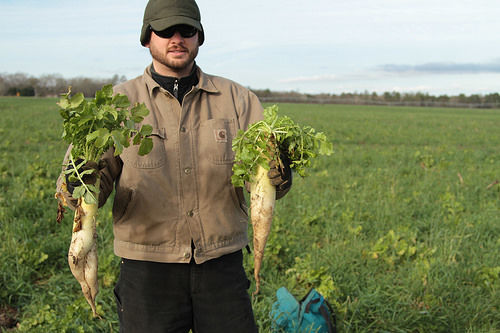Reduced erosion. Saved time and fuel. Improved nutrient cycling, soil moisture, and resiliency in the face of drought. You likely already know the potential benefits of no-till.
No-till farmers grow crops with minimal disturbance to their fields and the organisms that call them home. This builds healthier soils while reducing money spent on fuel and labor—a win-win.
1. Spread your residue during fall harvest.
Plowing isn’t the only way to prepare a field for next spring’s planting.
Evenly distribute residue that will be left in the field while harvesting your cash crop to manage against erosion and allow for a uniform breakdown of nutrients and organic matter. Residue can provide a valuable base of cover for your ground over winter.
2. Don’t forget about cover crops.
Farmers traditionally till to break up soil and prepare seedbeds. Over time, tillage can degrade structure and create highly compacted soils that seemingly “need” to be tilled before spring planting.
Plant cool-season cover crops to reduce compaction, build organic matter and hold your soil in place. Make sure to pick a cover crop species or mix that compliments your cash crop.
If you’re starting with a highly compacted field, use cover crop species that are meant to break up compaction. Daikon radish is often one great option.
3. Choose equipment with your end-goal in mind.
Simple but critical: Plan before you buy.
Will you plant next year’s cash crop into green cover, terminated cover or fall residue? Will you drill or broadcast your seeds?
Your operation may change over time, but establishing working goals now will keep you from buying equipment you don’t ultimately want.
Some USDA service centers have no-till drills and other equipment you can rent for minimal fees to get started. All offices are staffed with experts who’d be happy to talk through your specific management goals.
4. Treat no-till adoption as a marathon, not a sprint. Track results along the way.
Building healthy, resilient soil takes time. Some farmers report yield increases after their first year of no-till, but that shouldn’t be your main goal.
You can quantify several economic benefits of switching to no-till: fuel savings, time savings, eventual fertilizer reductions. By tracking these measurements along with changes in yield, you’ll gain a truer sense of the impact of no-till across your operation.
Have your soil tested at least once every four years and conduct your own informal assessments regularly. Healthy soils are full of living organisms.
5. Visit your local USDA service center.
Stop by your local service center to learn more about integrating no-till and other conservation practices into your management plan. They’re here to help you reach conservation goals that support your farm’s production needs.
Farmers across the country have reduced erosion, held valuable nutrients in-field, saved money on fuel, and increased their soil’s resiliency by minimizing tillage.
Is this the year you’ll try no-till? If so, having a strong plan in place will help you leave your plow parked for good.
For more information, contact Elizabeth Creech, public affairs specialist serving USDA’s Farm Service Agency, Natural Resources Conservation Service and Risk Management Agency, at [email protected].

